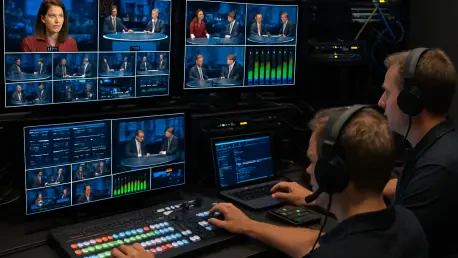The broadcasting industry stands at a critical juncture as it pivots from the long-standing Serial Digital Interface (SDI) systems to the more dynamic and scalable Internet Protocol (IP)-based workflows for live production. This shift, fueled by an ever-growing demand for flexibility in a multidevice, competitive media landscape, is fundamentally altering how content such as sports, news, and other real-time programming is created and delivered to audiences worldwide. With viewers expecting seamless, high-quality experiences across platforms, broadcasters face mounting pressure to adopt technologies that can keep pace with these evolving needs. IP offers a promising solution, providing the agility to handle complex productions while supporting innovative applications that SDI struggles to accommodate. As recent industry gatherings have demonstrated, the tools and strategies to make this transition are becoming increasingly accessible, signaling a turning point for the sector. Yet, this transformation is not without its complexities. Many broadcasters grapple with balancing legacy infrastructure against the promise of IP, navigating a path that requires both technological upgrades and a cultural shift in operational thinking. This journey, while challenging, is proving to be an essential step for staying relevant in a rapidly changing environment.
The Imperative of IP in Modern Broadcasting
The move to IP-based workflows has emerged as a non-negotiable priority for broadcasters striving to maintain a competitive edge in today’s media ecosystem. Unlike SDI, which is increasingly viewed as outdated due to its limited scalability and capacity, IP infrastructure offers the flexibility needed to meet the demands of modern content delivery. Industry experts from leading companies have emphasized that clinging to SDI is not a viable long-term strategy, especially as production requirements become more intricate with the rise of ultra-high-definition formats and multiplatform streaming. IP enables broadcasters to manage larger volumes of data and integrate new technologies seamlessly, ensuring they can adapt to future innovations without overhauling entire systems. This shift is not merely about keeping up with trends but about building a foundation that supports growth and responsiveness in an era where viewer expectations are constantly escalating.
Beyond the technical advantages, the transition to IP reflects a broader industry recognition of the need for agility in content creation and distribution. Broadcasters are under pressure to deliver real-time experiences that span traditional television, mobile devices, and online platforms, all while maintaining high-quality standards. IP facilitates this by allowing for more efficient signal routing and resource sharing, reducing the bottlenecks often encountered with SDI setups. Moreover, as live events like sports and breaking news require instantaneous production capabilities, IP’s ability to support remote and distributed workflows becomes a game-changer. This technological evolution is seen as essential for broadcasters to not only survive but thrive amidst fierce competition and fragmented audiences, paving the way for more dynamic and engaging content delivery methods.
Hybrid Workflows as a Practical Transition
A significant trend in the broadcasting sector is the adoption of hybrid infrastructures that combine elements of SDI, IP, and cloud technologies, offering a pragmatic approach to modernization. Recent industry surveys indicate that half of all broadcasters are currently employing this mixed model, a clear sign of its growing acceptance as a bridge to full IP integration. By incorporating protocols such as SMPTE ST 2110 alongside traditional SDI systems, organizations can test the waters of IP without fully abandoning familiar setups. This incremental strategy allows for a smoother learning curve, minimizing disruption to ongoing operations while gradually building the expertise and infrastructure needed for a complete shift. Hybrid models are particularly appealing to midmarket players who may lack the resources for an immediate overhaul but still recognize the importance of evolving their workflows.
This balanced approach also addresses the diverse needs within the industry, where not all broadcasters face the same operational demands or budget constraints. Hybrid systems provide the flexibility to scale IP adoption based on specific projects or content types, such as leveraging IP for remote sports coverage while maintaining SDI for in-studio news broadcasts. This adaptability ensures that broadcasters can prioritize investments where they yield the most impact, avoiding the risks associated with a rushed transition. Additionally, hybrid setups serve as a testing ground for emerging standards and technologies, enabling companies to refine their processes and address potential issues before committing to a fully IP-driven environment. As a result, this method is proving to be a vital stepping stone, fostering confidence in IP’s potential while respecting the practical realities of legacy systems.
Innovations Driving the IP Revolution
Vendors across the broadcasting technology space are playing a pivotal role in easing the transition to IP by introducing platforms that simplify the management of complex workflows. Solutions such as Ross Video’s Ultrix platform integrate multiple protocols, including SDI, SMPTE ST 2110, and Network Device Interface (NDI), into a single, user-friendly interface, significantly reducing the operational complexity of handling hybrid environments. Similarly, Grass Valley’s Agile Media Processing Platform (AMPP) offers a versatile framework that bridges traditional SDI advancements, such as 12G-SDI for 4K production, with IP-based systems, supporting a wide array of native applications for live content creation. These innovations are designed to lower the barriers to entry for broadcasters hesitant about moving away from familiar SDI setups, providing tools that streamline integration and enhance efficiency.
Equally important is the focus on ensuring that these technological advancements do not require a complete overhaul of existing infrastructure, a concern for many in the industry. By offering solutions that work alongside legacy systems, vendors enable broadcasters to protect their prior investments while incrementally adopting IP capabilities. This approach is critical for building trust in IP workflows, as it demonstrates that the transition can be managed without sacrificing reliability or quality during the shift. Furthermore, these platforms often come with robust support for scalability, allowing broadcasters to expand their IP usage as needs grow, whether for larger live events or more intricate multiplatform deliveries. Such innovations underscore a broader industry commitment to making IP adoption not just feasible but also strategically advantageous for organizations of varying sizes and capabilities.
Cloud Solutions Transforming Live Production
The rise of cloud-based production is reshaping the landscape of live broadcasting, offering unprecedented opportunities for remote and collaborative workflows that reduce reliance on physical infrastructure. Companies like TVU Networks, with their MediaMesh and SaaS offerings, are at the forefront of this trend, enabling real-time production and collaboration through web browsers, which is particularly valuable for fast-paced environments like live sports and breaking news. Similarly, Techex’s tx darwin platform targets high-profile sports broadcasters with microservices tailored for secure media processing and transport, addressing specific pain points in high-stakes scenarios. These cloud-native ecosystems highlight how distributed production models can enhance operational efficiency while maintaining the high standards expected in professional broadcasting.
Beyond accessibility, cloud solutions bring a level of scalability and cost-effectiveness that traditional setups often lack, allowing broadcasters to adjust resources dynamically based on project demands. This is especially beneficial for handling peak events where temporary spikes in production needs occur, as cloud platforms can allocate additional processing power without the need for permanent hardware investments. Moreover, the collaborative nature of cloud systems supports geographically dispersed teams, enabling seamless integration of talent and resources from various locations in real time. While concerns about latency and security persist, ongoing advancements in cloud technology are steadily addressing these issues, making it a compelling component of the IP transition. As adoption grows, the cloud is poised to become a cornerstone of modern broadcasting, redefining how live content is conceptualized and delivered to global audiences.
Interoperability: Building a Cohesive Ecosystem
A critical element in the shift to IP-based workflows is the emphasis on interoperability, ensuring that solutions from different vendors can integrate smoothly within a broadcaster’s ecosystem. Open interfaces and APIs, as prioritized by companies like Sony Electronics through their Networked Live portfolio and Grass Valley with their GV Media Universe, allow for the mixing and matching of tools without the risk of vendor lock-in. This openness is vital in a multivendor landscape where broadcasters often rely on equipment and software from multiple providers to meet their unique production needs. By fostering compatibility across platforms, the industry is mitigating the fragmentation that could otherwise hinder the adoption of IP technologies and slow progress toward standardized workflows.
The push for interoperability also reflects a broader understanding that no single company can dominate the broadcasting technology space, necessitating collaboration to drive innovation. This approach benefits broadcasters by providing the freedom to select best-in-class solutions tailored to specific requirements, whether for high-end sports coverage or midmarket news production. Additionally, open systems facilitate the integration of emerging standards and protocols, ensuring that investments remain relevant as the industry evolves. As more vendors commit to this principle, the result is a more cohesive and flexible environment where technological advancements can be adopted without the fear of incompatibility. This collaborative ethos is proving to be a linchpin in accelerating the transition to IP, fostering an ecosystem where innovation and practicality go hand in hand.
Camera Technology Enhancing Workflow Adaptability
Camera manufacturers are significantly contributing to the IP transition by developing equipment that supports both SDI and IP outputs, catering to the diverse needs of broadcasters across market segments. Panasonic’s KAIROS system, for instance, offers a versatile platform that accommodates mixed workflows, allowing seamless switching between traditional and IP-based setups without the need for external control units. Similarly, Sony’s HDC-5500 cameras, equipped with optional adapters, provide dual 12G-SDI and IP transport options like ST 2110 and NDI, ensuring compatibility with a range of production environments. This adaptability is essential for live production switchers and workflows, enabling broadcasters to tailor their technical setups based on specific project demands or budgetary constraints.
The flexibility offered by these advancements is particularly impactful for broadcasters who operate in hybrid environments, as it allows for a phased approach to IP adoption without compromising on quality or performance. High-end productions can leverage IP capabilities for cutting-edge features, while smaller operations can continue using SDI outputs until ready for a full transition. Furthermore, the integration of multiple transport options within a single camera system reduces the complexity and cost associated with managing disparate technologies, streamlining workflows for efficiency. As camera technology continues to evolve, it is becoming a linchpin in the broader push toward IP, ensuring that broadcasters have the tools needed to navigate the intersection of legacy and future-facing systems with confidence and precision.
Navigating the Challenges of IP Integration
Despite the clear benefits of IP-based workflows, the transition presents notable challenges that broadcasters must address to ensure a successful shift. Moving beyond SDI is not merely a matter of installing new equipment; it requires a fundamental rethinking of system design, signal flow, and operational paradigms. Industry insights from integration specialists highlight that one of the most significant hurdles is the integration of diverse platforms, each with its own protocols and standards, into a cohesive workflow. This complexity is compounded by the need for staff who possess both IT and broadcast expertise, a skill set that remains in short supply as the industry adapts to this technological convergence. Without the right talent, even the most advanced systems risk underperforming or failing to deliver expected outcomes.
Additionally, the pace of change within the IP landscape poses its own set of difficulties, as evolving standards and emerging frameworks can quickly render recent investments obsolete if not carefully planned. Broadcasters must navigate a delicate balance between adopting cutting-edge solutions and ensuring long-term compatibility, a task that demands strategic foresight and robust vendor support. Smaller and midmarket entities, in particular, may find these challenges daunting, as limited resources can restrict their ability to experiment with or fully commit to IP infrastructure. Addressing these obstacles requires not only technological innovation but also a cultural shift within organizations, fostering an environment where continuous learning and adaptation are prioritized. Only through such comprehensive efforts can the industry overcome the barriers to IP integration and unlock its full potential.
Ensuring Reliability in IP-Driven Environments
Reliability remains a cornerstone concern for live production, especially as broadcasters transition to IP environments where concerns about latency and system stability often arise. Vendors are actively addressing these issues with solutions designed to match or exceed the dependability of traditional SDI systems. Lawo’s HOME platform, for example, offers centralized management, security, and monitoring for IP-connected devices, ensuring that potential disruptions are quickly identified and mitigated. Meanwhile, Techex focuses on customizing cloud tools to meet broadcast-specific needs, avoiding the pitfalls of generic platforms by prioritizing high performance and failover capabilities. These efforts are critical for building trust in IP workflows, particularly for high-stakes content where even minor downtime can have significant repercussions.
Beyond technical solutions, the emphasis on reliability also involves educating broadcasters about the robustness of modern IP systems and how they can be tailored to specific operational requirements. Many in the industry still harbor reservations about IP due to early experiences with inconsistent performance, but ongoing advancements are steadily dispelling these doubts. By implementing redundant systems and leveraging sophisticated monitoring tools, vendors are demonstrating that IP can deliver the uptime and consistency needed for live events. This focus on dependability is not just about preventing failures but also about ensuring that broadcasters can confidently scale their operations, knowing that their infrastructure will support ambitious projects without compromise. As these solutions mature, reliability is becoming less of a barrier and more of a catalyst for widespread IP adoption.
Reflecting on a Transformative Journey
Looking back, the broadcasting industry’s journey toward IP-based live production marked a profound period of adaptation and innovation. The shift, which gained momentum over recent years, saw broadcasters grappling with the limitations of SDI while embracing the scalability of IP through hybrid models that bridged past and future technologies. Platforms from industry leaders streamlined complex workflows, while cloud solutions redefined remote production, and interoperable systems fostered a collaborative ecosystem. Challenges around integration and reliability were met with targeted advancements, ensuring that even the most demanding live content could be delivered with precision. As this transformation unfolded, it became clear that the path to IP was not just about technology but about reimagining how content connects with audiences. Moving forward, the focus should center on continued education and investment in skills that blend IT and broadcast expertise, alongside strategic partnerships with vendors to refine and future-proof systems. By prioritizing these steps, the industry can build on past achievements to create a resilient, agile framework for the next era of media production.









